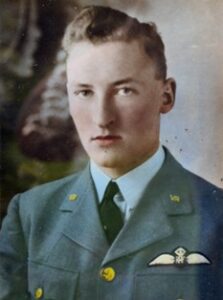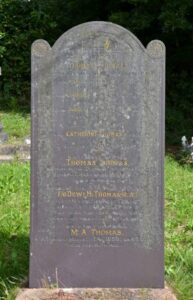Llandygwydd is a small village which sits along the River Teifi, around seven miles north-west of Newcastle Emlyn. According to the Dyfed FHS monument survey, there are memorials to three men who fell during the Great War inside the village Church, which is dedicated to St. Tygwydd. A further memorial commemorates the World War Two casualties from the village, and there are two more memorials to the former pupils of Llandygwydd School. Raymond Jones has kindly supplied photographs of the School and WW2 memorials for use on the website.
The Great War, 1914-1918
George Stewart Berrington Davies, Lieutenant, Rifle Brigade. George was born on 31 January 1899, the son of David and Joyce Berrington Davies, of Plas, Llangoedmore. He married Mary Joyce Emily Prioleau in 1917, and was commissioned from the OTC just after, on 29 August 1917, being posted to the 2nd Battalion, Rifle Brigade. George doesn’t look to have served during the Great War, but was instead part of the Allied army sent to North Russia, to take part in Operation Archangel. George returned home after the Allies pulled out of Russia, but the campaign had seriously damaged his health. He died on 26 October 1919, aged 20, and is buried at Llandygwydd (St. Tygwydd) Churchyard.
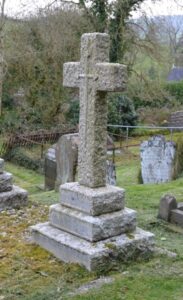
Benjamin Reynolds, Corporal, 15849, South Wales Borderers. Benjamin was born in Llandygwydd in 1890, the son of David and Judith Reynolds. He married Florence Mabel Cook at Merthyr in 1915, before embarking for France with the 8th Battalion, South Wales Borderers on 5 September 1915. The battalion was attached to 65 Brigade, 22nd Division, and was diverted to Salonika during October that year. Benjamin was killed in action in Salonika on 7 May 1917, aged 26. He is buried in Karasouli Military Cemetery, Salonika. Benjamin does not appear to be commemorated locally.
John Thomas, Private, G/20838, East Kent Regiment. John was born at Northampton in 1894, the son of David and Margaret Thomas. The family later resided at Ffynongarreg, Llandygwydd. John resided at Llangynin prior to the war, and enlisted at Carmarthen into the army. John was posted to the 1st Battalion, East Kent Regiment, which was in France attached to 16 Brigade, 6th Division. The Division had been on the Western Front since 10 September 1914, and had fought on the Aisne. It had fought in Flanders until 1916 when it took part in the Somme offensive. In 1917 it had fought at Arras and Cambrai. In the spring of 1918 the Division was one of those hit by the German Offensive on the Somme, which had been launched on 21 March, and took part in desperate fighting. John was killed on the first day of the offensive, on 21 March 1918, aged 25. He has no known grave, and is commemorated on the Arras Memorial, France.
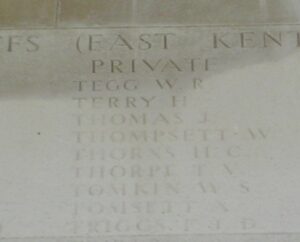
John George Thomas, Sapper, 44403, Royal Engineers. John was the son of Thomas and Martha Thomas, of Llandygwydd. John enlisted at Carmarthen into the Royal Engineers, and landed in France on 19 July 1915 with the 81st Field Company, Royal Engineers, which was attached to the 19th (Western) Division. The Division saw its first major action at the Battle of Loos on 25 September 1915, and the following year made a name for itself at the Battle of the Somme. During 1917 the Division fought at the Battle of Messines, and during the Third Battle of Ypres. In 1918 the Division was caught up in the German Spring Offensive near St. Quentin, where they suffered terrible casualties before being evacuated to Messines to rebuild. Unfortunately the Germans launched a fresh attack here in April 1918, and the 19th Division was again battered, moving south to the quieter French sector to rebuild. Lightning was to strike the division three times, as the German’s launched an offensive on the Aisne on 27 May 1918. John was killed in action here on 6 June 1918. He was 41 years old, and is buried at Marfaux British Cemetery, France.
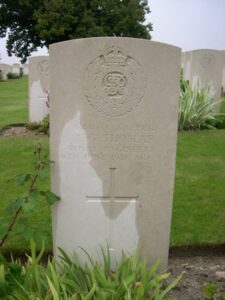
World War Two, 1939-1945
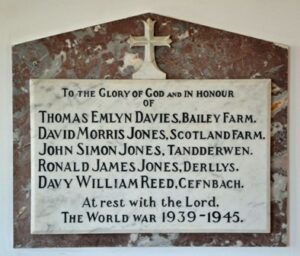
Thomas Emlyn Davies, B.A., Pilot Officer, 116950, Royal Air Force Volunteer Reserve. Thomas was the son of David and Elizabeth Davies, of Beili Farm. He served with the Royal Air Force as an Observer with 226 Squadron, RAF. The Squadron was equipped with the Bristol Blenheim when Thomas joined it, and re-equipped with the Douglas Boston early in 1942. Thomas was probably killed in a flying accident on 12 April 1942. He was 26 years old, and is buried at Harpswell (St Chad) Churchyard, England.
David Morris Jones, Sergeant, 549292, Royal Air Force. David was the son of William Morris Jones and Rachel Anne Jones, and the husband of Edna Jones, of Scotland Farm, Cwmcoy. He served with 10 Squadron, Royal Air Force, which was equipped with the Armstrong Whitworth Whitley. The squadron was attached to No. 4 Group of Bomber Command, and re-equipped with the Handley Page Halifax in December 1941, moving to RAF Leeming, Yorkshire. David was killed when his aircraft was lost on a raid on 3 July 1942. He was 25 years old, and is commemorated on the Runnymede Memorial, Surrey.
John Simon Jones, Sailor, Merchant Navy. John resided at Tandderwen, Neuadd Cross. He cannot presently be identified, although a John Seymour Jones, born in Aberporth, was drowned off the S.S. Albionic on 11 September 1940.
Ronald James Jones, Able Seaman, D/JX 188034, Royal Navy. Ronald was the son of John and Eleanor Jones, of Derllys. Ronald was a pre-war regular in the Royal Navy, and served aboard HMS Edinburgh. Edinburgh served as escort for the North Atlantic Convoys. On 2 May 1945, HMS Edinburgh was escorting Convoy QP-11, carrying a cargo of £45 million in gold bullion, when she was torpedoed by the German submarine U-456. The money was a part payment by Stalin for War Materials. After a desperate attempt by her crew to save her, and a gallant battle against further German aerial and sea-borne attacks, the Edinburgh was scuttled and sank. Ronald was killed in action aboard her on 2 May 1942, and is commemorated on the Plymouth Naval Memorial, Devon.
David John Leonard Lodwick, Sailor, Merchant Navy. David was the son of Benjamin and Mary Jane Lodwick, of Penralltyffynon, Cwmcoy. He served with the Merchant Navy aboard the SS Port Hunter, a London registered Cargo Steamer. Early in the morning of 12 July 1942, Port Hunter was struck on the port side by a torpedo from the German submarine U-582, and sank within two minutes, with the loss of 83 lives. David was 24 years old when he died that day, and is commemorated on the Tower Hill Memorial, London. David is commemorated on an individual plaque inside Llandygwydd Church which was removed from Capel Tygwydd after its closure.
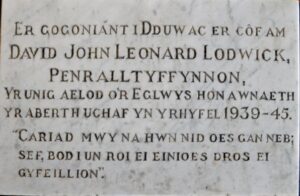
David William Reed, Cabin Boy, Merchant Navy. David, known as Dai, was the son of Robert and Sarah Reed, of Cefn-Bach, Llandygwydd. He served with the Merchant Navy aboard the SS Baron Carnegie, an Ardrossan registered Cargo Steamer. On 11 June 1941 she was on voyage from Swansea for Takoradi in ballast when she was torpedoed by German aircraft 15 miles West of St David’s Head, and sank whilst in tow. Dai was just 17 years old when he died that day, and is commemorated on the Tower Hill Memorial, London.
Dewi Hirwen Thomas, Flying Officer, 117517, Royal Air Force Volunteer Reserve. Dewi was the son of Thomas and Mary Anne Thomas, of Llechryd. He served with 169 Squadron, Royal Air Force, which was a tactical reconnaissance unit, equipped with the North American Mustang. In 1943 the Squadron re-equipped with the De Havilland Mosquito night fighter. Dewi was killed on a mission on 30 April 1943. He was 22 years old, and is commemorated on the Runnymede Memorial, Surrey.
